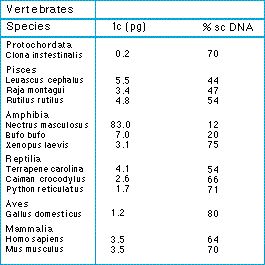Non-Coding DNA

Much of the DNA in many species probably does not produce or regulate the production of proteins. It is therefore called non-coding DNA.
For example, some geneticists estimate that only 10 - 25% of the human genome is actually coding DNA. Bacterial DNA, however, is much more economically organized.
Evidence for the fact that much of an organism's DNA is non coding comes from the large differences in genome sizes between species. It is unlikely that these differences are entirely due to differences in the numbers of informational genes. In the words of Orgel and Crick:
"It seems implausible that the number of radically different genes needed in a salamander is 20 times that in a man."
It has been observed that non-coding DNA is mainly repetitive DNA with the same bases repeated across the genome.
The geneticist Linda Partridge discusses the concept of non-coding DNA.
Table: amount of DNA and percentage copy DNA (sc DNA) in various animal species. Amount of DNA is expressed as haploid DNA content, 1C, in picograms. Single copy DNA, as opposed to repetitive DNA, actually encodes for proteins. From John and Miklos (1988).
How do we explain non-coding DNA?
| Next |



